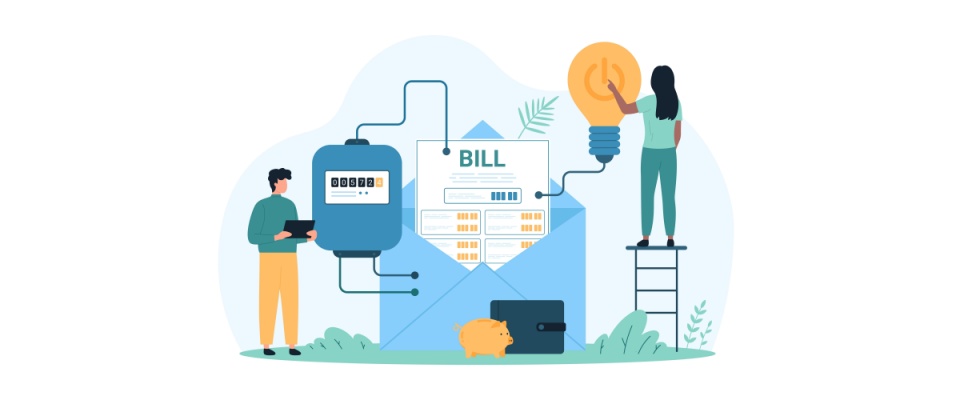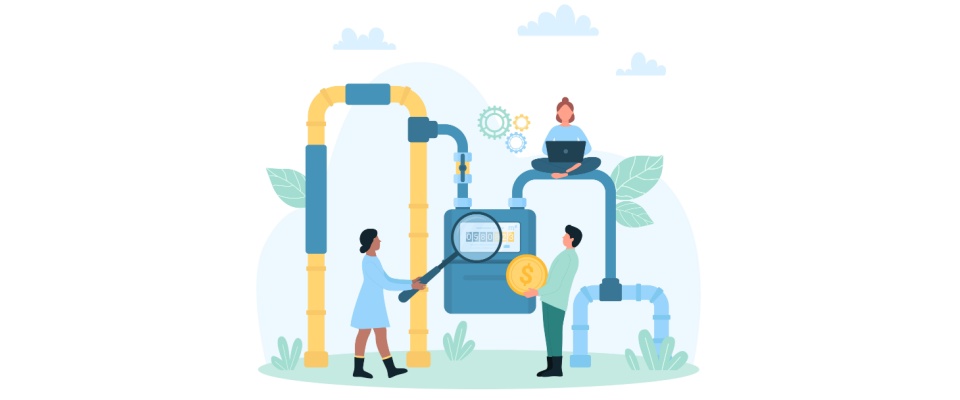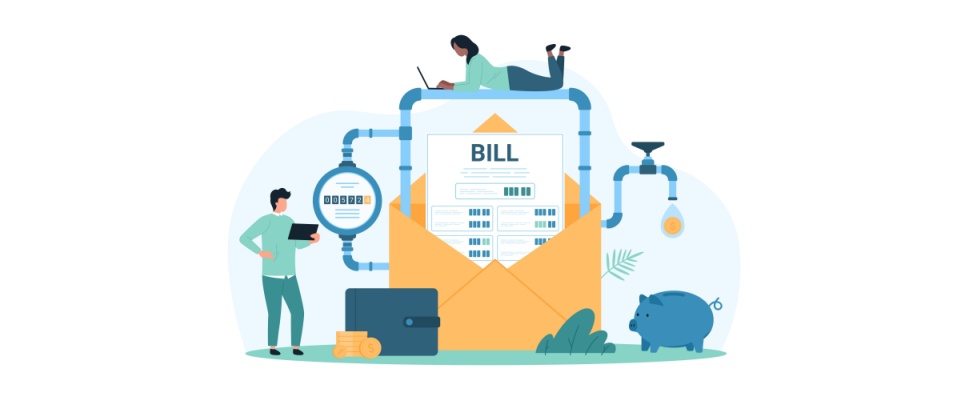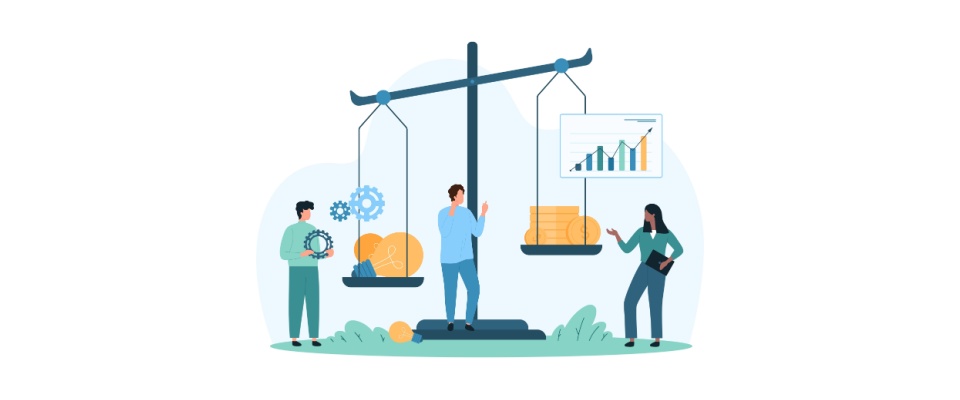When you’re renting an apartment, your monthly rent isn’t the only bill that matters. Utilities like electricity, gas, water, or internet can significantly add to your monthly expenses. That’s why understanding the average utility costs and how they’ve changed from year to year is an important part of budgeting and planning, especially if you’re moving into your first apartment.
According to recent data from RentCafe analysts, the average total cost of monthly utilities in 2025 is $444, an increase of 20% from just four years prior. For a clear view of what each utility costs in your state and how the cost of utilities has changed in the U.S., official utility data was aggregated for all 50 states plus Washington, D.C.
This report looks at electricity, gas, water, sewer, internet, and cable bills, covering national trends, highlighting key state-level differences, and showing you how your bills vary based on apartment size.
How have utility costs changed in recent years at a national level?
Where has the cost of electricity increased the most?
Which states had the biggest changes in gas costs?
Where are water and wastewater bills rising the most?
How electricity, gas, and water bills change based on apartment size
Where are internet and cable more expensive?
Tips for reducing utility costs
Methodology
How have utility costs changed in recent years at a national level?
Let’s start with the big picture. While total utility costs — including electricity, gas, water, sewer, internet, and cable — have risen compared to a few years ago, they’ve begun to stabilize more recently.
In 2021, the average monthly utility cost for a typical renter was around $370. From there, the rise hasn’t been dramatic year to year, but it’s been consistent:
- 2022 saw a notable jump to an average cost of $401, driven largely by higher electricity and sewer costs.
- 2023 ($436) and 2024 ($443) continued the upward trend, with electricity peaking at over $138 per month.
- In 2025, costs remain high but stable ($444), with minor increases in most utilities.
Where has the cost of electricity increased the most?
In recent years, electricity has been one of the most volatile utility expenses for apartment renters.
In 2021, the average electricity cost for renters was about $110 per month, and it continued to grow in the following years:
- 2022: $125/month
- 2023: $138/month
- 2024: $143/month
- 2025: $135/month
The drop visible in the most recent data from 2025 may be due to efficiency improvements or the drop in fuel prices, but it remains above pre-2022 levels.

Top 5 states with the highest increase in electricity costs from 2021 to 2025:
- Connecticut: +$79
- Hawaii: +$55
- Maine: +$54
- Rhode Island: +$52
- Arizona: +$43
Top 5 states with the smallest increase in electricity costs from 2021 to 2025:
- North Dakota: +$4
- Michigan: +$6
- South Dakota: +$6
- Montana: +$9
- Iowa: +$9
Which states had the biggest changes in gas costs?
Natural gas prices followed a more predictable path with lower volatility when it comes to average utility costs, but still trended upward overall.
National average of gas costs for renters:
- 2021: $82/month
- 2022: $91/month
- 2023: $101/month
- 2024: $92/month
- 2025: $94/month
While the average gas cost peaked in 2023 ($101), gas bills are rather stable at the moment. Still, renters in colder climates should plan for seasonal spikes.

Top 5 states with the highest increase in the monthly gas bill from 2021 to 2025:
- Georgia: +$66
- West Virginia: +$41
- District of Columbia: +$34
- Wyoming: +$32
- New York: +$29
Top 5 states with the biggest decrease in the monthly gas bill from 2021 to 2025:
- Maine: -$11
- New Mexico: -$9
- Arkansas: -$8
- Montana: -$7
- South Dakota: -$4
Where are water and wastewater bills rising the most?
Water and sewer bills might not be the first utility costs you think about when you’re renting, but they’ve also experienced recent changes.
Water bills are rising faster than other utilities, especially in states facing drought or infrastructure issues. Here’s how the average water cost has changed from 2021 on:
- 2021: $39/month
- 2022: $41/month
- 2023: $45/month
- 2024: $46/month
- 2025: $49/month
Top 5 states with the highest increase in average water bills from 2021 to 2025:
- Nevada: +$46 (which is a noteworthy 175% increase over just four years)
- California: +$38
- Wyoming: +$37
- Missouri: +$36
- Hawaii: +$31
Top 5 states with a decrease in average water bills from 2021 to 2025:
- Connecticut: -$24
- Kentucky: -$14
- South Carolina: -$11
- Arizona: -$6
- New Jersey: -$5
Sewer service charges saw a decrease from 2021 to 2022, followed by modest yearly increases:
- 2021: $56/month
- 2022: $52/month
- 2023: $59/month
- 2024: $60/month
- 2025: $62/month
Some states experienced a significant jump in wastewater costs in the past four years (up to a 230% increase in New Jersey), while others significantly decreased the average bill.
Top 5 states with the highest increase in average sewer bills from 2021 to 2025:
- Missouri: +$67
- New Jersey: +$66
- Hawaii: +$64
- Idaho: +$57
- Nebraska: +$51
Top 5 states with a decrease in average sewer bills from 2021 to 2025:
- South Carolina: -$52
- Maryland: -$31
- Connecticut: -$29
- Louisiana: -$28
- Florida: -$14

How electricity, gas, and water bills change based on apartment size
Utility costs also scale with how much space you’re using. More rooms usually mean more heating, cooling, and water usage.
One-bedroom apartment:
- Total utility cost (electricity, gas, water): $230 to 300/month
- Most common rental setup
- Electricity and water bills are usually the highest
Two-bedroom apartment:
- Total utilities (electricity, gas, water): around $350/month
- Better value per person if shared
- Higher heating and cooling costs
Three-bedroom apartment:
- Total utilities (electricity, gas, water):
- $380/month (3 people, regular consumption)
- $420/month (3 people, higher consumption)
- Ideal for roommates or families
- Highest overall bills, but lowest per-person average
Where are internet and cable more expensive?
Average internet costs remained stable in the past four years, with only minor fluctuations:
- 2021: $37/month
- 2022: $37/month
- 2023: $36/month
- 2024: $39/month
- 2025: $38/month
Top 5 states with the highest increase in internet costs from 2021 to 2025:
- Florida: +$35
- Pennsylvania: +$35
- Arizona: +$20
- Kansas: +$20
- Louisiana: +$20
Top 5 states with the biggest decrease in internet costs from 2021 to 2025:
- Missouri: -$20
- Montana: -$20
- North Carolina: -$20
- Ohio: -$20
- Wisconsin: -$20
Cable TV, by contrast, continued to trend upward in price even as fewer people rely on it.
Apart from a decrease in 2023 compared to 2022, the average cost has been increasing from year to year:
- 2021: +$46
- 2022: +$58
- 2023: +$53
- 2024: +$59
- 2025: +$60
Top 5 states with the highest increase in the average cable bill from 2021 to 2025:
- District of Columbia: +$42
- Idaho: +$23
- North Dakota: +$23
- Wyoming: +$20
- Arkansas: +$18
Top 5 states with the biggest decrease in the average cable bill from 2021 to 2025:
- Washington: -$27
- Texas: -$27
- New Jersey: -$17
- Connecticut: -$15
- West Virginia: -$5

Tips for reducing utility costs
Knowing how the average utility costs change over time is helpful, but applying that knowledge to your real life is what matters most. As a renter, you’re likely on a budget where even small changes in monthly bills can make a difference.
Utility costs vary depending on your location, apartment size, seasonal usage, and your building’s energy efficiency. That’s why it’s crucial to think beyond average numbers and take a proactive approach to managing your bills.
1. Ask what utilities are included before signing a lease. If rent seems high, but it covers gas and water, you might be saving in the long run.
2. Make a realistic budget. Use this guide to estimate your average utility costs by apartment size and location. Add that to how much you’ll pay for rent, and you’ll have a bigger picture of your overall monthly budget.
3. Compare provider plans. See if you can switch your internet or electricity provider for a better deal.
4. Watch seasonal trends, as heating and cooling can double your bill. Plan ahead during the summer and winter to avoid unexpected spikes.
Some electricity providers, such ResidentShield Power, offer fixed-rate plans that help you avoid unexpected bills year-round.
5. Improve energy efficiency. Use smart plugs, LED bulbs, and programmable thermostats. Shut off lights and water when you’re not using them.

6. Share the space. Having roommates lowers the per-person share of utility costs.
7. Double-check your bills. If you see a sudden spike, reach out to your provider or review your usage.
Whether you’re renewing a lease, comparing apartments, or moving to a new city, being aware of how average utility costs change from year to year can help you make smarter, more sustainable financial choices.
Methodology
To assess and compare average monthly utility costs for renters across the U.S., the following data were compiled:
- Electricity: Average bill calculated annually by multiplying each state’s average residential electricity price (latest data compiled: February 2025) by the state’s average monthly residential consumption (in kWh, 2023).
- Gas: Average bill calculated annually by multiplying each state’s average residential natural gas price by the state’s average residential natural gas consumption.
- Water and sewer: Average bill based annually on the rates (service charge plus consumption per 1,000 gallons) of the largest water utility in each state, determined by population served. Consumption estimates come from the U.S. Geological Survey, converted from hundreds of cubic feet per capita and adjusted for average household size.
- Internet and cable: Average bill determined annually by identifying the least expensive TV and internet plans available locally from top state and national providers. Coverage data was sourced from CableTV, and pricing came from provider websites for the most affordable deals and bundles.
Historical comparisons were included to help identify trends in utility costs over time, using the most recent data available as of 2025.
Important Notes
The data for each year was collected at different times of the year, so slight variations may result from seasonal fluctuations (e.g., higher heating bills in winter, higher electric bills in summer).
This guide is designed to help renters plan smarter, avoid surprises in their utility bills, and make informed housing choices. All values are rounded for clarity and meant to reflect realistic U.S. averages based on consulted data and utility patterns.
This article may be redistributed under fair use, provided the portion used is limited and properly attributed to ResidentShield.com or this page.
